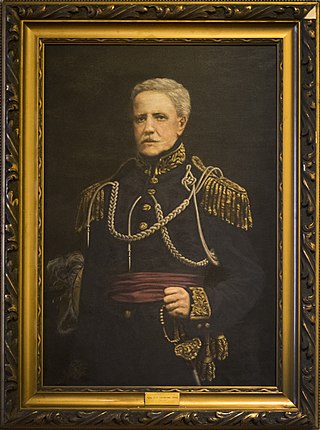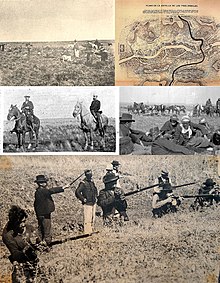
Agustín Pedro Justo Rolón was an Argentine military officer, diplomat and politician, who served as the president of Argentina from 1932 to 1938 during the Infamous Decade. Justo took part in the coup of 1930, becoming president two years later thanks to widespread electoral fraud. His presidency was part of the period known as the Infamous Decade, which lasted from 1930 until 1943. He established the country's central bank and introduced a nationwide income tax.

The Battle of Caseros was fought near the town of El Palomar, Buenos Aires Province, Argentina, on 3 February 1852, between the Army of Buenos Aires commanded by Juan Manuel de Rosas and the Grand Army led by Justo José de Urquiza. The forces of Urquiza, caudillo and governor of Entre Ríos, defeated Rosas, who fled to the United Kingdom. This defeat marked a sharp division in the history of Argentina. As provisional Director of the Argentine Confederation, Urquiza sponsored the creation of the Constitution in 1853, and became the first constitutional President of Argentina in 1854.

Aparicio Saravia da Rosa was a Uruguayan politician and military leader. He was a member of the Uruguayan National Party and was a revolutionary leader against the Uruguayan government.

The Battle of Cerrito, was a battle for the War of Independence of the Viceroyalty of the Río de la Plata, between the royalist forces who had control of the city of Montevideo and the rebel forces of the government of Buenos Aires.

Angel Mateo Canavery was an Argentine military man, who participated in the Conquest of the Desert under the command of General Julio Argentino Roca. He also took part against the Montoneras of Ricardo López Jordán, and against Civic Union troops during the Revolution of the Park.

The 1943 Argentine coup d'état, also known as the Revolution of '43, was a coup d'état on 4 June 1943 that ended the government of Ramón Castillo, who had been fraudulently elected to the office of vice-president before succeeding to the presidency in 1942 as part of the period known as the Infamous Decade. The military was opposed to Governor Robustiano Patrón Costas, Castillo's hand-picked successor, a major landowner in Salta Province and a primary stockholder in the sugar industry. The only serious resistance to the military coup came from the Argentine Navy, which confronted the advancing army columns at the Navy Petty-Officers School of Mechanics.

Juan de Canaveris was an Piedmontese lawyer and politician, who served during the viceroyalty of Río de la Plata as accounting officer in the Tribunal de Cuentas de Buenos Aires. He had achieved a high social status in the Viceroyalty of the Río de la Plata, where he supported the revolutionary movements of May, being the only neighbor of Italian origin who attended in the Open Cabildo, of May 22, 1810.
Juan José Canaveris (1780–1837) was an Argentine jurist and politician, who served as military man, lawyer, notary, prosecutor and accountant of Buenos Aires. In 1809 he was honored by the Junta Suprema de Sevilla, for his heroic participation in the defense of Buenos Aires, during the English invasions in the Río de la Plata.

Isabelino Canaveris was an Uruguayan patriot, military, revolutionary and politician, who served as president of the National Party in the Argentine Republic. He participated in most of the armed confrontations between the Blancos and Colorados.
Events in the year 1871 in Uruguay.
Juan Manuel Canaveris (1804-1868) was an Argentine jurist and politician, who served in Buenos Aires and Montevideo as attorney, teacher and military man. He participated of the escort of honor in the funerals of Manuel Dorrego, and collaborated in the early days of government of Juan Manuel de Rosas.

Ángel Canaveris (1847–1897) was an Argentine pediatrician and psychiatrist, who had a preponderant role in the beginnings of Uruguayan Medicine. He served in Montevideo as general director of the Hospital Vilardebó and Hospital Maciel.

Tomás Onésimo Canavery (1839–1913) was an Argentine Catholic priest and military chaplain, who served under the command of Bartolomé Mitre during the War of the Triple Alliance. He participated in most of the military actions against the Paraguayan forces, being promoted to lieutenant colonel in the same battlefield by order of General Juan Andrés Gelly y Obes.

Alonso Muñoz de Gadea (1630s-1708) was a Spanish politician, accountant and military officer who served in Buenos Aires during the Viceroyalty of Peru as Alcalde, Procurador and Mayordomo of the Cathedral Mayor of the city.

José Brito del Pino (1797–1877) was a Uruguayan soldier and patriot, who participated in the Argentine War of Independence, the Cisplatine War and the Uruguayan Civil War. He was one of the founding members of the Partido Nacional Uruguayo.

Batallón de Voluntarios Rebajados de Buenos Aires was a 19th-century Argentine military unit formed mainly with veterans of the Brazilian War and the expeditionaries to the Desert of 1833 and 1834. It was a special unit of the Federal Party of active participation during the civil war between federales and unitarios.
Battle of Sauce was a battle between the troops of the Argentine National government, and the Federal rebels commanded by Ricardo López Jordán. It took place on May 20, 1870, in the Arroyo del Sauce, Entre Ríos.

The Revolution of 1904 was a civic-military revolt led by Aparicio Saravia against the government of José Batlle y Ordóñez in Uruguay. It was the last military conflict between Blancos and Colorados.

The Peruvian-Bolivian War was a warlike confrontation between Peru and Bolivia in the years 1841 and 1842.

José Pons de Ojeda, later known as León de Pallejas was a Uruguayan general of Spanish origin who participated in the First Carlist War, the Argentine Civil Wars and the Paraguayan War.

















